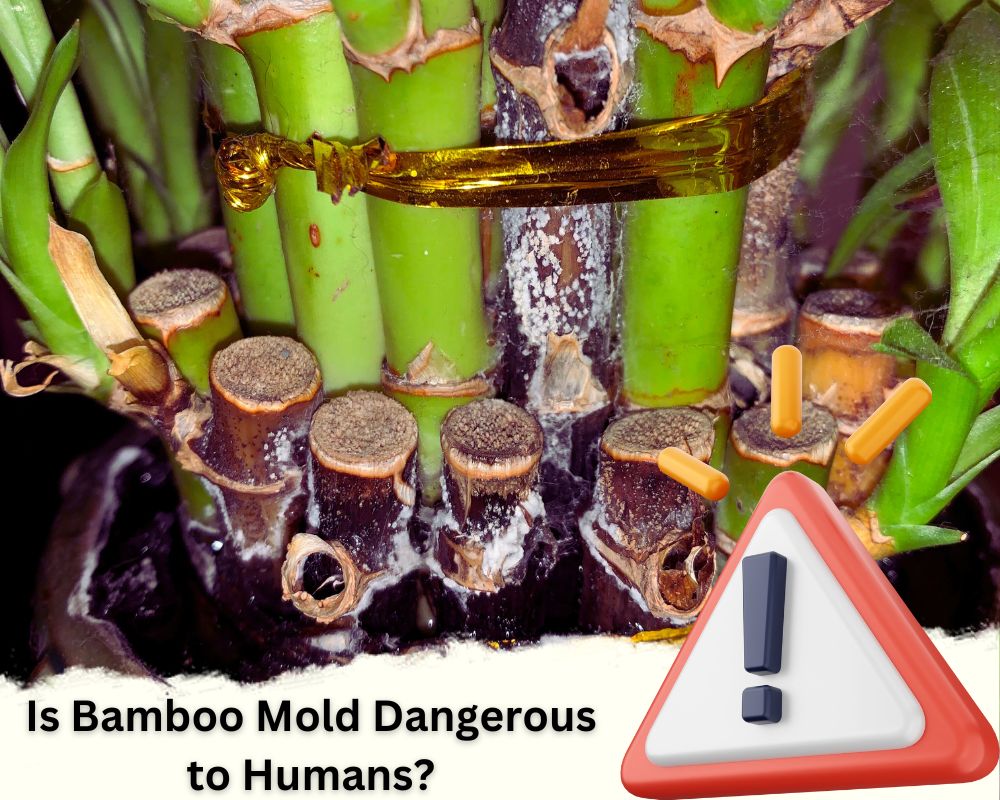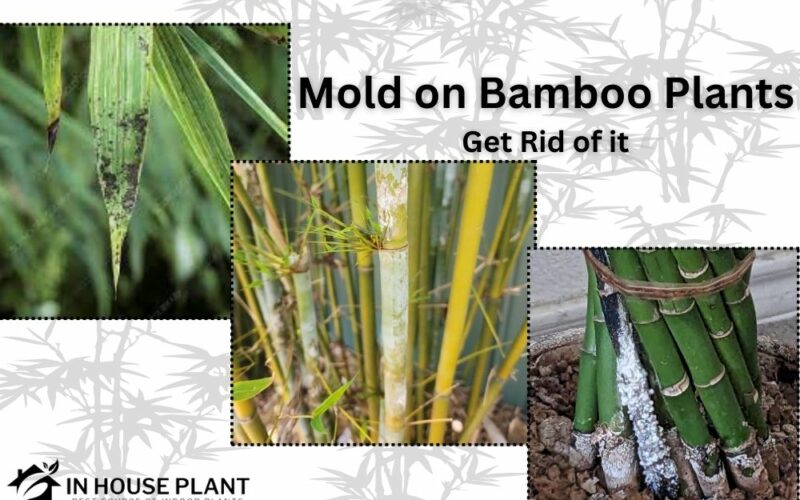Mold on bamboo plants can be white or black, Based on my experience, white mold on bamboo is often saprophyte fungus which is a sign of another problem, however, I found out some people confused the Mealybugs with White Mold. So If you spot white stuff on your bamboo plant, they are often mealybugs. About Black mold on the bamboo plants, it is sooty mold. Hence to get rid of the mold on bamboo plants for good, first you must detect the culprits.
Hi, I’m a horticultural consultant with a PhD in plant protection science (the field of plant pathology). I’m here to answer all your questions about bamboo mold and show you how to detect, treat, and prevent them. If you think your bamboo is infected with mold, stay with me in this post to tell you everything you should know about it from detection to control.
First, let me answer “Is bamboo mold dangerous to humans?” most people are concerned about it and ask me.
➡ You can also hear the audio version of this article.
Is Bamboo Mold Dangerous to Humans?

I’m a horticultural consultant whose academic major is plant protection (plant pathology). I’m here to share with you my knowledge and experiences with mold on bamboo plants. Indoor bamboo plants (especially Lucky Bamboo) are trendy among indoor gardeners. I love them too.
Some people after seeing mold on bamboo plants, get concerned about their health. one of the most frequent question that people ask me is “Is bamboo mold dangerous?”. Indeed, every mold can be dangerous for humans in terms of its allergenic aspects.
➡ As I told you above, molds are a kind of fungi that produce thousands of tiny spores. Their spores can cause breathing disorders in some people. Hence, you should get rid of them as soon as possible.
➡ In addition, if you don’t control them, they will be extended to other plants and even things such as furniture in your house. In this situation, their control will be hard.
Hence, if you ask me “Is Bamboo mold dangerous to humans?” I will answer “Yes, they’ll get trouble-makers if you don’t control them”.
What is Mold on Houseplants?
 Although Bamboo plants are grouped as low-maintenance indoor plants, most people are involved with various bamboo problems. In my previous posts, I told you about bamboo diseases and pests, especially considering the yellow, brown, and white spots on bamboo leaves.
Although Bamboo plants are grouped as low-maintenance indoor plants, most people are involved with various bamboo problems. In my previous posts, I told you about bamboo diseases and pests, especially considering the yellow, brown, and white spots on bamboo leaves.
However, one of the most frequent questions that people often ask me is about the mold on bamboo plants. So, I decided to especially discuss it in this post. I hope after reading this article, you can detect your bamboo problem correctly and treat it perfectly. However, I’m walking with you during this post and you can ask me your questions below this page. let’s start.
I know you are concerned about your bamboo plant but first, let’s consider mold on houseplants generally. It will help you to detect your bamboo problem correctly.
Do you know what is mold?
➡ Mold is a fungi that thrives on the foliage of your houseplants, potting soil, furniture, showers, and anywhere with high humidity.
Molds are invisible residents of our house. Their spores are flying anywhere in our living space. We only see them when the humidity increases and their spores land on a wet surface, creating their colony there.
This surface can be missed leaves of your houseplant or its wet soil. due to it not being a mycology class, I don’t mention the name (scientific name) of molds on indoor plants. But if it is important for you, aware me below this page to tell you.
Mold on Houseplant Leaves can be white or black. Most often the black molds on houseplants are saprophytes, while the white molds can be saprophytes, secondary pathogens, or obligate pathogens. I will discuss them in detail in the following.
Mold on Houseplant Soil can be white or yellow and are often saprophytes. However, they don’t kill your indoor plant, but they are a sign of overwatering that can kill your houseplant.
Now, let to continue this post, especially on mold on bamboo plants. keep reading.
What Is Bamboo White Mold?

As mentioned above, molds are a kind of fungi on bamboo. you may spot white mold on bamboo leaves (foliage) or on the soil.
This surface can be misted leaves of your houseplant or its wet soil. Due to it not being a mycology class, I don’t mention the name (scientific name) of molds on indoor plants. But if it is important for you, aware me below this page to tell you.
When I (as a plant pathologist) spot white mold on plants’ leaves, first get concerned about Powdery mildew (a dangerous obligate pathogen). Fortunately, it’s not important for bamboo plants (I‘ve not read any report of Powdery mildew on bamboo plants, if you know about it, please inform me too.)
Hence, if you spot white mold on bamboo, it is a saprophyte fungus that can be a sign of high humidity around your bamboo plant.
If you grow your bamboo in soil, you may see white mold on the soil. Please note that they don’t kill your bamboo, but they are a sign of overwatering.
Some indoor gardeners think overwatering is not an important issue for lucky bamboo and tell me: “Lucky bamboo grows in water, so, it is ok with soggy soil.” If you think like them, please read my article “The Best Way to Water Lucky Bamboo” before losing your lovely plant.
Anyway, you must get rid of white mold on the bamboo plant (foliage or soil) due to:
- It will give an ugly appearance to your plant.
- Mold on bamboo plants or soil produces spores that can cause allergies in some people.
- If they cover the leaves, will decrease the efficiency of photosynthesis and your bamboo plant will get weaker and weaker.
Before showing you how to get rid of white mold on bamboo plants, I want to ensure you don’t mistake it for other white stuff on bamboo leaves or soil. keep reading.
The White Stuff on Bamboo or Soil that Are not Mold.
There is some white stuff on houseplants that people make mistakes with white mold. So, I decided to show them here.
Mealybugs vs Mold on Bamboo Plants

As you see in the picture, they are white tiny bugs on houseplants (such as bamboo) that produce white powdery stuff on leaves and stems. They suck the sap plant and if you don’t get rid of them quickly will kill your bamboo plant.
Read my article about mealybugs on houseplants to know more and learn how to control them.
Salt on the Soil Surface vs Mold on Bamboo soil

Watering with tap water or overfertilization will cause creating a salt layer on topsoil. some people mistake it for white mold on houseplant soil.
Please note that lucky bamboo is not a real bamboo plant and belongs to Dracaena. It is very sensitive to salts in tap water such as chloride and Fluoride. Watering lucky bamboo with tap water will cause tip-burn on leaves.
In addition, lucky bamboo is very sensitive to over-fertilization. read my article about fertilizing lucky bamboo to have more healthy plants.
Anyway, if you think your problem is mold on your bamboo plant, Keep reading to tell you how to kill it.
How to Get Rid of Mold on Bamboo Plants?
To kill white mold on bamboo plants, I recommend the following tips:
- Stop over-watering.
- Remove and eradicate the infected leaves.
- You can spray the infected parts with your DIY fungicides like Neem oil, or vinegar.
➡ To make your DIY neem oil spray, you must:
- Mix two teaspoons of neem oil with a half-gallon of water.
➡ To make your DIY vinegar spray, you must:
- Mix two tablespoons of apple cider vinegar with a quart of water.
What Is Black Sooty Mold on Bamboo Plant?

Sooty mold is a common bamboo fungus that can epidemy on the leaves in high-humidity environments, especially if your plant is infested with sap-sucking pests such as aphids or mealybugs.
Black sooty mold not only diminishes the appeal of your bamboo plant but also reduces photosynthesis and the plant will lose its vigor.
In addition, the infected leaves cannot gain enough sunlight, turn yellow, and will fall. Hence, you must get rid of them.
How to Get Rid of Black Sooty Mold on Bamboo Plant?
To control sooty mold on bamboo plants, you must follow the below tips:
- First, remove the infected parts and eradicate them.
- locate your plant in a bright place with indirect sunlight.
- Reduce humidity by providing airflow and stop overwatering.
- Control the sap-sucking pests such as aphids and mealybugs.
- You can also spray the foliage with neem oil.
How to Prevent Mold on Bamboo?
Let me tell you a golden tip to prevent every plant disease or pest:
“Break at least one of the corners of the pest or disease triangle”

💡 Do you know what “Pest or Disease Triangle” is?
For every infection or infestation, three factors must be present at the same time:
- Host (in this article it is your bamboo plant).
- Pest or Pathogen (in this article it is mold).
- Suitable environmental conditions for pests or pathogens.
The Suitable environmental conditions for sooty mold on bamboo plants is a damp and dim place. The sap-sucking pests such as aphids and mealybugs, produce honeydew on leaves that promote growing mold on leaves.
Hence to prevent sooty mold on bamboo plants, the best way is to break the Suitable environmental corner of the mold infestation triangle by:
- Control aphids and mealybugs.
- Avoid overwatering.
- Put your plant in a bright indirect place with suitable airflow.
Conclusion
Here, I tried to answer one of the most common concerns of indoor gardeners: Mold on bamboo plants. I discussed various kinds of bamboo molds (Black and White mold) and told you about controlling them.
I hope it has helped you to have more greenery houses. Please improve this post by sharing your experiences and ideas about molds on bamboo plants below this page.

Elahe Rabiei
Hi, I’m Elaheh. My Academic major is plant protection, and houseplants are my expertise. As a houseplant lover, my house is full of indoor plants and it is my passion to take care of them. Hence, I’m here to share my knowledge and experience about growing healthy houseplants. I am also a plant protection advisor, so feel free to ask me any questions you may have.


Thanks, Elahe. Very comprehensive and easy solution. Thankful to you for sharing valuable info on treating white bamboo Mould
You’re very welcome! I’m so glad you found the solution helpful. It’s great to hear that the information was clear and valuable to you. Don’t hesitate to reach out if you have any more questions about bamboo care!